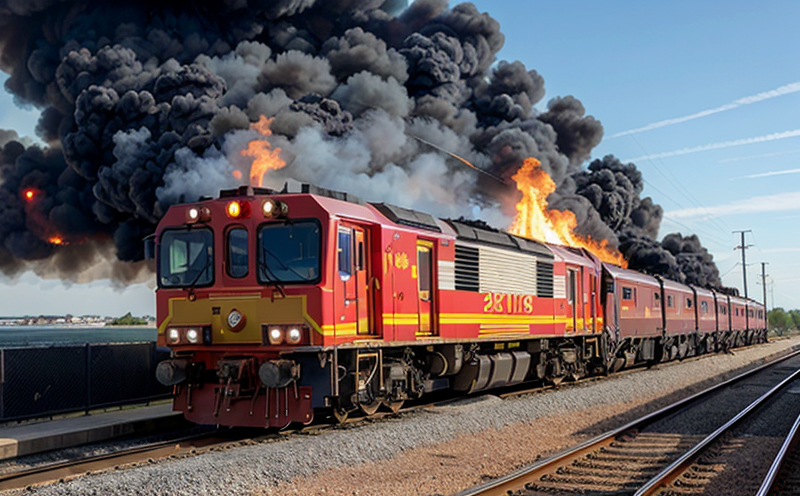Reaction-to-Fire Testing of Marine Upholstery Fabrics
The marine industry is a critical sector that demands stringent quality and safety standards to ensure the well-being of its crew and passengers. One crucial aspect of this requirement is ensuring that all materials, including upholstery fabrics, meet fire safety standards. Reaction-to-fire testing plays a pivotal role in evaluating how these materials behave when exposed to heat or flame. This service specifically focuses on marine upholstery fabrics used in various maritime applications such as passenger ships, yachts, and commercial vessels.
Reaction-to-fire tests are conducted using standardized methods that simulate real-world fire scenarios. The most common test for this purpose is the Vertical Burn Test (ASTM E603), which evaluates how a material burns under specific conditions. This test helps determine important parameters such as flame spread rate, smoke production, and heat release rate. Understanding these metrics allows stakeholders to make informed decisions about selecting appropriate materials that can withstand fire hazards without compromising safety.
For marine upholstery fabrics, the choice of material is not only a matter of comfort but also one of survival. In case of emergencies on board ships or trains, quick evacuation relies heavily upon non-flammable and self-extinguishing properties of seat covers and cushions. These characteristics ensure that in the event of fire, the materials do not contribute to further escalation by continuing to burn once removed from an ignition source.
Our laboratory uses advanced equipment such as cone calorimeters (ASTM E1354) which measure the heat release rate during a fire test and pyrolysis gas chromatographs (ASTM D6869), which identify volatile organic compounds released into the atmosphere. We also employ scanning electron microscopes to analyze char formation, providing detailed insights into the combustion behavior of different fabrics.
The results from these tests are critical for meeting regulatory requirements set forth by organizations like the International Maritime Organization (IMO). Compliance with international standards ensures not only safety but also peace of mind knowing that products meet global expectations regarding fire resistance. By partnering with us, you gain access to expertise in interpreting test data and translating it into actionable insights that drive product improvements.
It is essential for manufacturers of marine upholstery fabrics to understand the importance of this testing process. Not only does it safeguard lives but also protects investments by reducing liability risks associated with potential accidents caused by substandard materials. Investing time and resources into proper fire safety testing early in development stages can save costs later when dealing with recalls or redesigns due to non-compliance issues.
By choosing our service, you benefit from comprehensive support throughout the entire testing process—from initial consultation on selecting appropriate samples through final analysis and interpretation of results. Our team comprises experienced professionals who specialize in fire safety testing within the marine sector, ensuring accuracy and consistency across all tests performed.
Benefits
Ensures compliance with international maritime regulations such as IMO standards
Improves product safety by identifying potential fire hazards early in the development process
Reduces liability risks associated with accidents caused by substandard materials
Saves costs through early identification of issues, avoiding costly redesigns or recalls later on
Enhances brand reputation and customer trust
Achieves regulatory compliance which is essential for market access in many countries
Why Choose This Test
The Reaction-to-Fire Testing of Marine Upholstery Fabrics service offered by our laboratory stands out due to its comprehensive approach and state-of-the-art facilities. Here are some reasons why choosing this test is beneficial:
We provide a full range of services from initial consultation through final analysis, ensuring that every step of the process is handled professionally.
Our team consists of highly experienced professionals who specialize in fire safety testing within the marine sector, guaranteeing accuracy and consistency across all tests performed.
We use cutting-edge equipment such as cone calorimeters (ASTM E1354) which measure heat release rates during a fire test and pyrolysis gas chromatographs (ASTM D6869), which identify volatile organic compounds released into the atmosphere. These tools allow us to conduct thorough analyses.
We offer detailed reporting, including visual documentation of char formation via scanning electron microscopy. This provides clients with a clear understanding of their material's behavior under fire conditions.
Choosing our service means investing in the future safety and reliability of your products while also safeguarding against potential legal challenges or financial losses due to non-compliance issues. Additionally, it demonstrates commitment to excellence which is crucial for maintaining competitive advantage in today’s marketplace.
Environmental and Sustainability Contributions
The Reaction-to-Fire Testing of Marine Upholstery Fabrics service contributes positively towards environmental sustainability by promoting the use of safer, more sustainable materials. Through our rigorous testing process, we help manufacturers identify alternative fabrics that not only meet strict fire safety requirements but also have lower environmental impacts throughout their lifecycle.
Reduction in greenhouse gas emissions: By selecting flame-retardant finishes or inherently fire-resistant fibers like fiberglass or certain types of glass wool, manufacturers can reduce the need for additional chemicals and processes that contribute to carbon footprints.
Promotion of recyclability: Some modern alternatives to traditional petroleum-based plastics are made from renewable resources such as plant cellulose or recycled polyester. These materials not only perform well in fire safety tests but also offer opportunities for reuse after their useful life cycle has ended.
Our service encourages innovation by exploring new sustainable solutions while ensuring they remain effective against fire hazards. This balance between environmental responsibility and product performance is key to addressing global challenges related to climate change and resource depletion without compromising safety standards.





